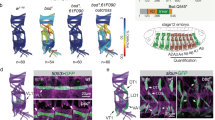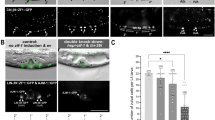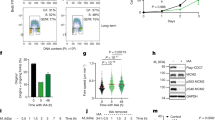Abstract
Temporal control of cell division is critical for proper animal development. To identify mechanisms involved in developmental arrest of cell division, we screened for cell-cycle mutants that disrupt the reproducible pattern of somatic divisions in the nematode C. elegans. Here, we show that the cdc-14 phosphatase is required for the quiescent state of specific precursor cells. Whereas budding yeast Cdc14p is essential for mitotic exit, inactivation of C. elegans cdc-14 resulted in extra divisions in multiple lineages, with no apparent defects in mitosis or cell-fate determination. CDC-14 fused to the green fluorescent protein (GFP–CDC-14) localized dynamically and accumulated in the cytoplasm during G1 phase. Genetic interaction and transgene expression studies suggest that cdc-14 functions upstream of the cki-1 Cip/Kip inhibitor to promote accumulation of CKI-1 in the nucleus. Our data support a model in which CDC-14 promotes a hypophosphorylated and stable form of CKI-1 required for developmentally programmed cell-cycle arrest.
This is a preview of subscription content, access via your institution
Access options
Subscribe to this journal
Receive 12 print issues and online access
$209.00 per year
only $17.42 per issue
Buy this article
- Purchase on Springer Link
- Instant access to full article PDF
Prices may be subject to local taxes which are calculated during checkout




Similar content being viewed by others
References
Sulston, J.E. & Horvitz, H.R. Post-embryonic cell lineages of the nematode, Caenorhabditis elegans. Dev. Biol. 56, 110–156 (1977).
Kornfeld, K. Vulval development in Caenorhabditis elegans. Trends Genet. 13, 55–61 (1997).
Hong, Y., Roy, R. & Ambros, V. Developmental regulation of a cyclin-dependent kinase inhibitor controls postembryonic cell cycle progression in Caenorhabditis elegans. Development 125, 3585–3597 (1998).
de Nooij, J.C., Letendre, M.A. & Hariharan, I.K. A cyclin-dependent kinase inhibitor, Dacapo, is necessary for timely exit from the cell cycle during Drosophila embryogenesis. Cell 87, 1237–1247. (1996).
Lane, M.E. et al. Dacapo, a cyclin-dependent kinase inhibitor, stops cell proliferation during Drosophila development. Cell 87, 1225–1235. (1996).
Koff, A., Ohtsuki, M., Polyak, K., Roberts, J.M. & Massague, J. Negative regulation of G1 in mammalian cells: inhibition of cyclin E- dependent kinase by TGF-β. Science 260, 536–539 (1993).
Cueille, N. et al. Flp1, a fission yeast orthologue of the S. cerevisiae CDC14 gene, is not required for cyclin degradation or rum1p stabilisation at the end of mitosis. J. Cell Sci. 114, 2649–2664 (2001).
Trautmann, S. et al. Fission yeast Clp1p phosphatase regulates G2/M transition and coordination of cytokinesis with cell cycle progression. C. Biol. 11, 931–940 (2001).
Gruneberg, U., Glotzer, M., Gartner, A. & Nigg, E.A. The CeCDC-14 phosphatase is required for cytokinesis in the Caenorhabditis elegans embryo. J. Cell Biol. 158, 901–914 (2002).
Shou, W. et al. Exit from mitosis is triggered by Tem1-dependent release of the protein phosphatase Cdc14 from nucleolar RENT complex. Cell 97, 233–244 (1999).
Visintin, R., Hwang, E.S. & Amon, A. Cfi1 prevents premature exit from mitosis by anchoring Cdc14 phosphatase in the nucleolus. Nature 398, 818–823 (1999).
Pereira, G., Manson, C., Grindlay, J. & Schiebel, E. Regulation of the Bfa1p–Bub2p complex at spindle pole bodies by the cell cycle phosphatase Cdc14p. J. Cell Biol. 157, 367–379 (2002).
Boxem, M. & van den Heuvel, S. lin-35 Rb and cki-1 Cip/Kip cooperate in developmental regulation of G1 progression in C. elegans. Development 128, 4349–4359 (2001).
Sherr, C.J. & Roberts, J.M. CDK inhibitors: positive and negative regulators of G1-phase progression. Genes Dev. 13, 1501–1512 (1999).
Tan, P.B., Lackner, M.R. & Kim, S.K. MAP kinase signaling specificity mediated by the LIN-1 Ets/LIN-31 WH transcription factor complex during C. elegans vulval induction. Cell 93, 569–580 (1998).
Bardin, A.J., Visintin, R. & Amon, A. A mechanism for coupling exit from mitosis to partitioning of the nucleus. Cell 102, 21–31 (2000).
Pereira, G., Hofken, T., Grindlay, J., Manson, C. & Scheibel, E. The Bub2p spindle checkpoint links nuclear migration with mitotic exit. Mol. Cell 6, 1–10 (2000).
Mendenhall, M.D. An inhibitor of p34CDC28 protein kinase activity from Saccharomyces cerevisiae. Science 259, 216–219 (1993).
Schwob, E., Bohm, T., Mendenhall, M.D. & Nasmyth, K. The B-type cyclin kinase inhibitor p40SIC1 controls the G1 to S transition in S. cerevisiae. Cell 79, 233–244 (1994).
Mailand, N. et al. Deregulated human Cdc14A phosphatase disrupts centrosome separation and chromosome segregation. Nature Cell Biol. 4, 317–322 (2002).
Kaiser, B.K., Zimmerman, Z.A., Charbonneau, H. & Jackson, P.K. Disruption of centrosome structure, chromosome segregation, and cytokinesis by misexpression of human Cdc14A phosphatase. Mol. Biol. Cell 13, 2289–2300 (2002).
Skowyra, D., Craig, K.L., Tyers, M., Elledge, S.J. & Harper, J.W. F-box proteins are receptors that recruit phosphorylated substrates to the SCF ubiquitin-ligase complex. Cell 91, 209–219 (1997).
Verma, R. et al. Phosphorylation of Sic1p by G1 Cdk required for its degradation and entry into S phase. Science 278, 455–460 (1997).
Pagano, M. et al. Role of the ubiquitin-proteasome pathway in regulating abundance of the cyclin-dependent kinase inhibitor p27. Science 269, 682–685 (1995).
Visintin, R. et al. The phosphatase Cdc14 triggers mitotic exit by reversal of Cdk-dependent phosphorylation. Mol. Cell 2, 709–718 (1998).
Slingerland, J. & Pagano, M. Regulation of the cdk inhibitor p27 and its deregulation in cancer. J. Cell Physiol. 183, 10–17 (2000).
Wong, A.K. et al. Genomic structure, chromosomal location, and mutation analysis of the human CDC14A gene. Genomics 59, 248–251 (1999).
Wood, W. (ed.) The Nematode Caenorhabditis elegans. (Cold Spring Harbor Laboratory, Cold Spring Harbor, New York, 1988).
Wei, A. et al. Efficient isolation of targeted Caenorhabditis elegans deletion strains using highly thermostable restriction endonucleases and PCR. Nucleic Acids Research 30, e110 (2002).
Boxem, M., Srinivasan, D.G. & van den Heuvel, S. The Caenorhabditis elegans gene ncc-1 encodes a cdc2-related kinase required for M phase in meiotic and mitotic cell divisions, but not for S phase. Development 126, 2227–2239 (1999).
Acknowledgements
We thank N. Dyson, A. Hart, I. The, P. Ernst and D.G. Srinivasan for critical reading of the manuscript. We are grateful to the Caenorhabditis Genetics Center (National Institutes of Health, National Center for Research Resources), V. Ambros, A. Fire, I. Greenwald, U. Gruneberg, S. Kim, Y. Kohara and J. Schumacher for strains and reagents. This research was supported by grants from the National Institutes of Health to S.v.d.H. R.M.S. was supported by grants from the American Cancer Society and the MGH Fund for Medical Discovery.
Author information
Authors and Affiliations
Corresponding author
Ethics declarations
Competing interests
The authors declare no competing financial interests.
Supplementary information
Rights and permissions
About this article
Cite this article
Saito, R., Perreault, A., Peach, B. et al. The CDC-14 phosphatase controls developmental cell-cycle arrest in C. elegans. Nat Cell Biol 6, 777–783 (2004). https://doi.org/10.1038/ncb1154
Received:
Accepted:
Published:
Issue Date:
DOI: https://doi.org/10.1038/ncb1154
This article is cited by
-
The tapeworm interactome: inferring confidence scored protein-protein interactions from the proteome of Hymenolepis microstoma
BMC Genomics (2020)
-
Conservation of Cdc14 phosphatase specificity in plant fungal pathogens: implications for antifungal development
Scientific Reports (2020)
-
Transcriptional analysis of the conidiation pattern shift of the entomopathogenic fungus Metarhizium acridum in response to different nutrients
BMC Genomics (2016)
-
Boolean genetic network model for the control of C. elegans early embryonic cell cycles
BioMedical Engineering OnLine (2013)
-
Regulation of APC/C-Cdh1 and Its Function in Neuronal Survival
Molecular Neurobiology (2012)



